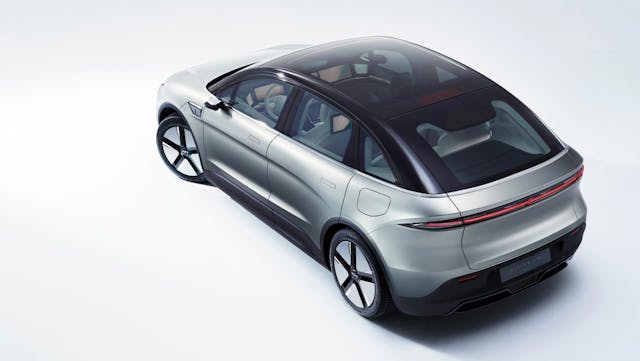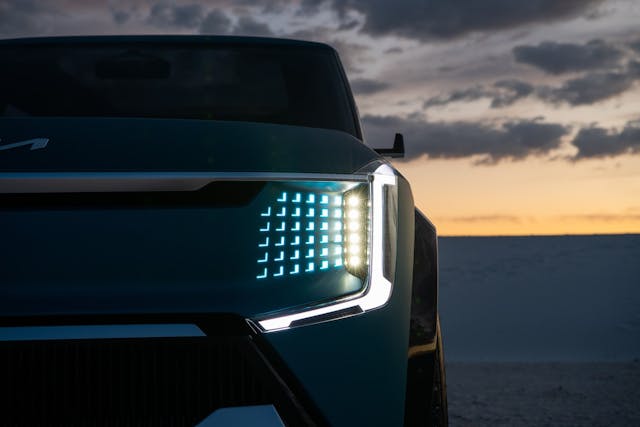Sony and Honda team up for EVs, Kia’s electric pickup dreams, IndyCar delays hybrids
Sony and Honda hook up for EV venture

Intake: Honda and Sony are joining forces to develop electric cars which could be on sale as early as 2025. The two companies will partner in a new, as yet un-named firm, to develop the new models in an “alliance which brings together the strengths of our two companies offers great possibilities for the future of mobility,” said Honda CEO Toshihiro Mibe. Honda will take care of the vehicle manufacture and after-sales, while Sony’s responsibility will, of course, be the electronics—specifically imaging and sensors, communications, and in-car entertainment.
Exhaust: Despite having shown off near-production-ready EVs at CES, Sony was never going to go it alone into the auto business. Honda, meanwhile, needs help to grow and the company has previously been full of praise for its new partner. “A new entry like Sony will really revitalize the industry,” said Mibe earlier this year. As automakers scramble to grab the EV-related headlines, we’re seeing a handful of different approaches. Some, like Ford, are choosing to stand up the EV business unit ion its own. Others are simply making grand forecasts about coming EVs. Honda’s slightly different route may give it the edge it needs in the free-for-all that is the pending wave of electric vehicles.
Kia wants in on EV pickups

Intake: At a virtual investor conference earlier this week, Kia unveiled an ambitious roadmap for ramping up its EV portfolio. The plan calls for 14 new battery-electric vehicles (BEVs) by 2027, with at least two BEVs launched per year beginning in 2023. While many of these BEVs are expected to be sedans or SUVs akin to Kia’s current EV6, the Korean automaker also plans to add two electric pickup trucks—one “dedicated model” (targeting mainstream markets like North America, China, and Korea), and one “strategic model” (entry-level, low-cost) for emerging markets. Kia says that the electric pickup will be produced in the United States from 2024 on. Expect more details about sizing, dimensions, and even pricing to roll out over the coming months.
Exhaust: Kia’s sibling company, Hyundai, also rolled out an ambitious goal for the coming years, but it didn’t explicitly mention pickups. Kia will look to join several other automakers currently cooking up electrified trucks, including Ford, Chevy, upstarts like Rivian, and as of earlier this week, Ram. Whether or not the Korean brand can conjure the right mix of size, styling and features to woo American truck buyers remains to be seen. If any truck in recent memory has hit that mark, it’s the new Ford Maverick.
IndyCar’s 900-horsepower hybrid engine will have to wait

Intake: IndyCar’s electrified future will have to wait as supply chain issues continue to plague the motorsports ecosystem. The debut of its 900-horsepower, 2.4-liter, twin-turbocharged V-6 hybrid engine—which was originally scheduled for 2023—is now delayed until 2024, according to IndyCar. Current engine providers Chevrolet and Honda will continue to use their 2.2-liter twin-turbo V-6s until then. “We have finished development and dyno testing of our new internal combustion engine,” said Honda Performance Development president David Salters, “and once the hybrid system component supply chain issues are sorted, we’ll begin track testing of the new hybrid power unit.” That first track test is currently scheduled for March 30th at Sebring.
Exhaust: While IndyCar’s hybrid powertrain delay is hardly a major supply chain effect compared to, say, the computer chip shortage or surging gas prices, it’s still a major inconvenience for the series. Since Penske purchased IndyCar in 2020, the division has ridden a wave of momentum with young talent, fierce finishes, and new faces in victory lane. Year-over-year viewership was up 19% in 2021 and 10% in 2020. The flashy new hybrid powertrain, in a way, will help Indy keep up with the Joneses: NASCAR’s well-received Next Gen stock car and F1’s new-for-2022 open-wheelers. If there is any bright side to the delay, it’s that the current platform has provided some stellar on-track action, especially at the Indianapolis 500, the series’ most important race. Perhaps another year of refinement for the hybrid powertrain will allow IndyCar to build on its current climb.
Ford dumps electric scooters to focus on EVs

Intake: Hot on the heels of recent restructuring news, Ford announced the sale of its Spin electric scooter division to European mobility company Tier Mobility AG, according to a report from Automotive News. The deal gets TIER into the North American market, while allowing Ford to focus on what they do best: make personal transportation vehicles. Terms of the sale were not disclosed, but Ford acquired the mobility startup for $100 million back in 2018. That said, Ford isn’t completely exiting the business, as Franck Louis-Victor, Vice President of New Businesses at Ford Motor Company said, “We are pleased to remain in the mix as a strategic investor in Tier and look forward to their continued growth.”
Exhaust: Don’t hold your breath for Mach-E branded scooters anytime soon, but Ford’s continued investment in mobility scooters means the door isn’t fully shut on their dreams of providing modern solutions to modern big-city problems. Ford’s 2018 acquisition of the iconic Michigan Central station was part of an effort to corral some of the buzz around terms like “last mile logistics” and “mobility solutions” that had investors fawning over startups such as Lyft, Bird, and Uber. The sale of Spin proves that may have been wishful thinking. That said, now that Michigan Central Station has research money from Google, perhaps it will one day reach those lofty dreams of mobility solutions for all types of American commuters.
Russia kicked out of Formula 1 over Ukraine invasion

Intake: Formula 1 has torn up Russia’s contract to host Grand Prix racing after Vladimir Putin’s invasion of neighboring Ukraine. Russia had a deal in place until 2025, with plans to move the race to Putin’s home town of St. Petersburg in 2023. Initially, F1 cancelled this year’s Sochi event scheduled for September, but then decided to kick Russia from the calendar indefinitely. “Formula 1 can confirm it has terminated its contract with the Russian Grand Prix promoter meaning Russia will not have a race in the future,” a statement from F1 said.
Meanwhile, Haas, the only American team in F1 currently, has reportedly sacked its Russian driver Nikita Mazepin. Mazepin’s father is a billionaire oligarch said to have close ties to Putin and was sponsoring the team, but Haas removed all traces of his Uralkali brand from its car during the season’s first test as news of the Russian invasion broke. Brazilian-American driver Pietro Fittapaldi is favorite to replace the Russian.
Exhaust: Motor racing’s response to the Ukraine crisis hasn’t been very well coordinated. The FIA, F1’s governing body, said that Russian and Belarusian drivers could continue to race under an FIA flag, but that wasn’t deemed strong enough by many nations own organizers. Motorsport UK banned Russian and Belarusian drivers from racing in Britain, meaning that Mazepin would have had to skip the race at Silverstone. Mazepin did little to boost Haas’ efforts during the 2021 season, earning zero points for the team.

